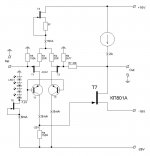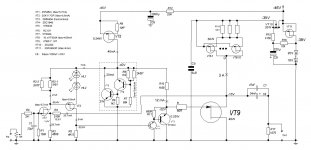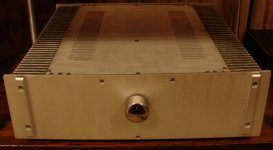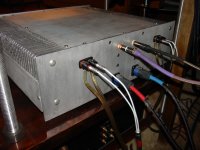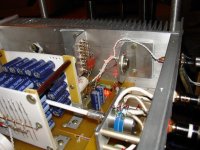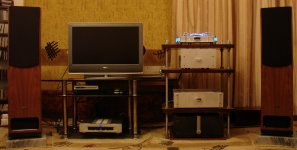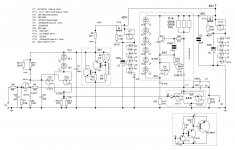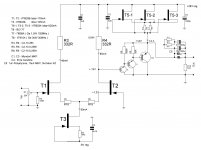I just have managed to get some russian SITs, KP801A and KP801G. The first is 60W 3A (at Vgs=0 and Vds=10V), and the second is 100W 6A part. I am not sure that they will do OK just at single common source stage, with my big PMC EB1i speakers. As an inevitable compromise, I am thinking about two stages and some GNFB. How would you comment and what could be advised to the enclosed schematics?
For getting the indicated 8mA+8mA currents at diff stage, I plan to use matched 4pcs of 2N5462 p-ch jFETs, with Idss around 6mA and 4mA operation point. Using of just 4mA+4mA at diff stage I guess could be not sufficient, because of the SIT Ciss and some gate leakage current.
For getting the indicated 8mA+8mA currents at diff stage, I plan to use matched 4pcs of 2N5462 p-ch jFETs, with Idss around 6mA and 4mA operation point. Using of just 4mA+4mA at diff stage I guess could be not sufficient, because of the SIT Ciss and some gate leakage current.
Attachments
Last edited:
Thanks, Juma and ZenMod. Some people are very careful to PSRR issues, and said that I shall have no PSRR at the -16V PS rail. Because of this, better to use standard source follower at the output. Majority of people tend to bring the PSRR on the top of everything. I am, on the contrary, find from listening experience, that even with high PSRR, the PS e-caps adds substantially to the sound.
I tend to reject this proposal, since the low intrinsic Rds resistance of SITs allows to benefit from the common source output stage, and moreover amplification of this stage adds essentially to GNFB. Due to the same reason (low Rds), PSRR of the source follower variant will be not as good as with MOSFETs, and this will spoil SIT specific advantages.
With the common source output stage, possible cure for -16V PSRR could be just following the output cap design receipes.
I tend to reject this proposal, since the low intrinsic Rds resistance of SITs allows to benefit from the common source output stage, and moreover amplification of this stage adds essentially to GNFB. Due to the same reason (low Rds), PSRR of the source follower variant will be not as good as with MOSFETs, and this will spoil SIT specific advantages.
With the common source output stage, possible cure for -16V PSRR could be just following the output cap design receipes.
Last edited:
Thanks, Juma and ZenMod. Some people are very careful to PSRR issues, and said that I shall have no PSRR at the -16V PS rail. Because of this, better to use standard source follower at the output. Majority of people tend to bring the PSRR on the top of everything. I am, on the contrary, find from listening experience, that even with high PSRR, the PS e-caps adds substantially to the sound.
I tend to reject this proposal, since the low intrinsic Rds resistance of SITs allows to benefit from the common source output stage, and moreover amplification of this stage adds essentially to GNFB. Due to the same reason (low Rds), PSRR of the source follower variant will be not as good as with MOSFETs, and this will spoil SIT specific advantages.
With the common source output stage, possible cure for -16V PSRR could be just following the output cap design receipes.
I tend to agree with your conclusions about topology choice. Also, (IMHO) it's OK to take care about PS but it's better to handle the ripple and other nasty artefacts in the PSU (by using capacitance multiplier, various regulators...) than to compromise the amp design due to PSRR worries...
I tend to agree with your conclusions about topology choice. Also, (IMHO) it's OK to take care about PS but it's better to handle the ripple and other nasty artefacts in the PSU (by using capacitance multiplier, various regulators...) than to compromise the amp design due to PSRR worries...
Thanks, Juma, for your supporting words. I shall start probably next week SIT measurements, in order to be sure with optimum voltages and currents through the SITs.
At the end, I have to confess, that I have not managed to convince myself to go ahead with the schematics indicated at the beginning.
I decided to implement SE version, that is well investigated by me, and I am sure in it. The SE schematics with SITs at the output is the following:
I decided to implement SE version, that is well investigated by me, and I am sure in it. The SE schematics with SITs at the output is the following:
Attachments
Here are some shots of the SIT amp. Since it sounds really good, I have put some efforts to decorate it, with a custom machined volume control knob (bulk titanium) and titanium screws visible at the front panel. The volume control potentiometer is Penny&Giles RF15 10kOhms.
One could mention, that I tend to some rare components. It is partially true, I simply get some pleasure from using things, that are not easy obtainable from a department store.
One could mention, that I tend to some rare components. It is partially true, I simply get some pleasure from using things, that are not easy obtainable from a department store.
Attachments
Last edited:
Other amps that I compare to this SIT amp are the following:
1) Similar SE topology, but with HF bjt transistors instead of SIT
2) No GNFB SE amp, with Ge bjts at the output
Moreover, a tube SE 300B amp is playing at the comparisons, it was specially acquired for this purpose. Some description of this tube amp is here
http://www.nemrussia.com/home/production/a300se
http://www.ultraudio.de/nem_a_300_se.html
It is visible at the bottom of the equipment carrier, standing on the floor.
1) Similar SE topology, but with HF bjt transistors instead of SIT
2) No GNFB SE amp, with Ge bjts at the output
Moreover, a tube SE 300B amp is playing at the comparisons, it was specially acquired for this purpose. Some description of this tube amp is here
http://www.nemrussia.com/home/production/a300se
http://www.ultraudio.de/nem_a_300_se.html
It is visible at the bottom of the equipment carrier, standing on the floor.
Attachments
Last edited:
What can I say about sound differences
All are perfect at mids and highs. They overtake even the tube amp. Most differences are at the bass region, maybe because my PMC EB1i speakers are not an easy load. Value of output impedance says almost nothing about bass impression. In my case, it depends more on a kind ot transistors used at the output. Namely, I still find, that the No GNFB amp with Ge bjts at the output gives the most "detailed" and naturally sounding bass, athough other amps also produce "big" and powerful sound.
Most time I am listening to the SIT amp and to the No GNFB Ge amp.
All are perfect at mids and highs. They overtake even the tube amp. Most differences are at the bass region, maybe because my PMC EB1i speakers are not an easy load. Value of output impedance says almost nothing about bass impression. In my case, it depends more on a kind ot transistors used at the output. Namely, I still find, that the No GNFB amp with Ge bjts at the output gives the most "detailed" and naturally sounding bass, athough other amps also produce "big" and powerful sound.
Most time I am listening to the SIT amp and to the No GNFB Ge amp.
Last edited:
- Status
- This old topic is closed. If you want to reopen this topic, contact a moderator using the "Report Post" button.
- Home
- Amplifiers
- Pass Labs
- SIT amp idea
